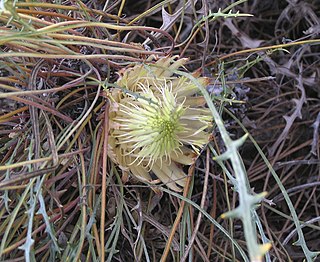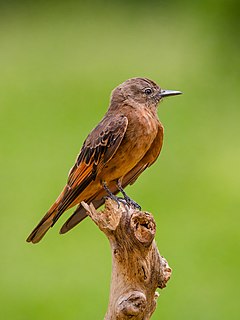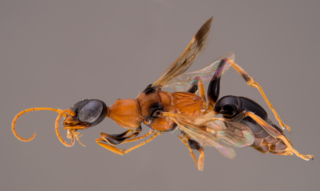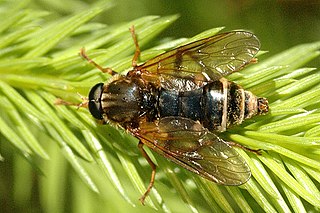
The curlew sandpiper is a small wader that breeds on the tundra of Arctic Siberia. The genus name is from Ancient Greek kalidris or skalidris, a term used by Aristotle for some grey-coloured waterside birds. The specific ferruginea is from Latin ferrugo, ferruginis, "iron rust" referring to its colour in breeding plumage.

The ruddy shelduck, known in India as the Brahminy duck, is a member of the family Anatidae. It is a distinctive waterfowl, 58 to 70 cm in length with a wingspan of 110 to 135 cm. It has orange-brown body plumage with a paler head, while the tail and the flight feathers in the wings are black, contrasting with the white wing-coverts. It is a migratory bird, wintering in the Indian subcontinent and breeding in southeastern Europe and central Asia, though there are small resident populations in North Africa. It has a loud honking call.

The emerald cockroach wasp or jewel wasp is a solitary wasp of the family Ampulicidae. It is known for its unusual reproductive behavior, which involves stinging a cockroach and using it as a host for its larvae. It thus belongs to the entomophagous parasites.

Banksia rufa is a species of prostrate shrub that is endemic to the south-west of Western Australia. It has broadly linear, pinnatifid or pinnatipartite leaves with between five and twenty lobes on each side, yellow, orange or brownish flowers in heads of forty or more, and glabrous, egg-shaped follicles.

The cliff flycatcher is a species of bird in the tyrant flycatcher family, Tyrannidae. The cliff flycatcher is the only species in the genus Hirundinea after the swallow flycatcher was merged, becoming subspecies Hirundinea ferruginea bellicosa. It is native to South America, where its natural habitats are cliffs and crags in the vicinity of subtropical or tropical dry forest, subtropical or tropical moist lowland forest, subtropical or tropical moist montane forest, and heavily degraded former forest.
Banksia rufa subsp. rufa is a subspecies of Banksia rufa. It was known as Dryandra ferruginea subsp. ferruginea until 2007, when Austin Mast and Kevin Thiele sunk all Dryandra into Banksia. Since the name Banksia ferruginea had already been used, Mast and Thiele had to choose a new specific epithet for D. ferruginea and hence for this subspecies of it. As with other members of Banksia ser. Dryandra, it is endemic to the South West Botanical Province of Western Australia. As an autonym, it is defined as encompassing the type material of the species.

Lomatia ferruginea, commonly known as fuinque, is a small evergreen tree in the family Proteaceae.

Patella ferruginea, commonly known as the ribbed Mediterranean limpet, is a species of sea snail, a true limpet, a marine gastropod mollusk in the family Patellidae, one of the families of true limpets. It is a large limpet, native to the western Mediterranean Sea, and although common in the past, it is now rare and restricted to only a few locations.

Darlingia ferruginea, commonly known as the brown silky oak, is a rainforest tree of the family Proteaceae from Northern Queensland.
Helicia ferruginea, commonly named hairy honeysuckle or rusty oak, is a species of rainforest trees, of eastern Australia, from the flowering plant family Proteaceae.

Ampulex dementor is a species of cockroach wasp native to Thailand, described in 2014 by Michael Ohl of the Museum für Naturkunde in Berlin, Germany. The species name was selected by visitors to the museum in an effort to raise awareness among the public of issues in taxonomy and the description of biodiversity.

Hakea ferruginea, commonly known as rusty hakea, is shrub in the family Proteacea. It has flat leaves and white to cream-coloured flowers from late winter to mid-summer and is endemic to Western Australia.

Nephrotoma ferruginea is a species of large crane fly in the family Tipulidae.

Coenomyia ferruginea is a species of fly in the family Xylophagidae. It is found in Europe.

Caenoscelis ferruginea is a species of silken fungus beetle in the family Cryptophagidae. It is found in Europe & Northern Asia and North America.
Lycoperdina ferruginea is a species of handsome fungus beetle in the family Endomychidae. It is found in North America.
Odontomera ferruginea is a species of fly in the family Richardiidae.
Leuctra ferruginea, the eastern needlefly, is a species of rolled-winged stonefly in the family Leuctridae. It is found in North America.

Epicauta ferruginea is a species of blister beetle in the family Meloidae. It is found in North America.
Sethenira ferruginea is a species of leaf-footed bug in the family Coreidae. It is found in the Caribbean Sea, Central America, and North America.













